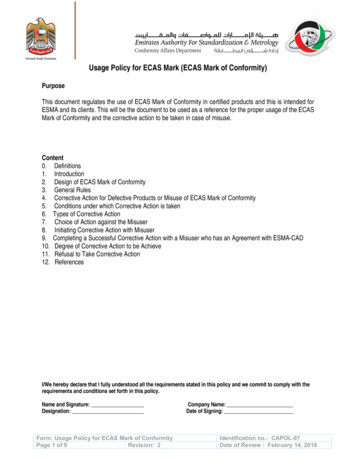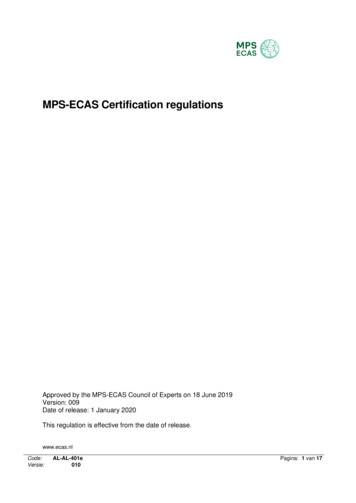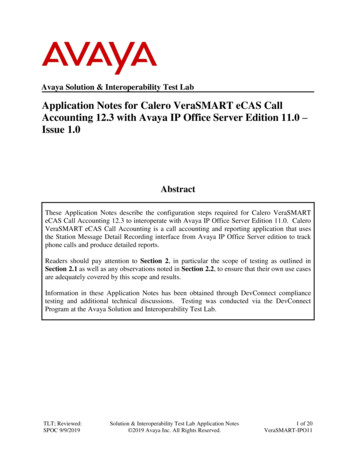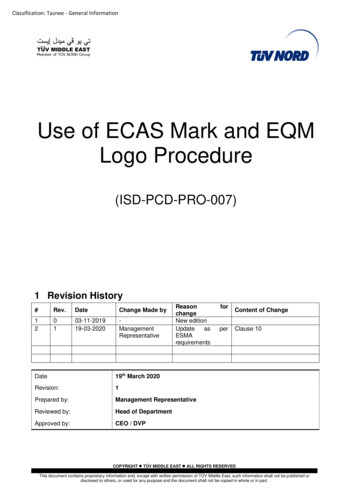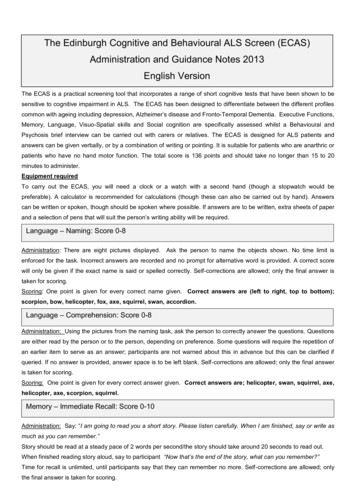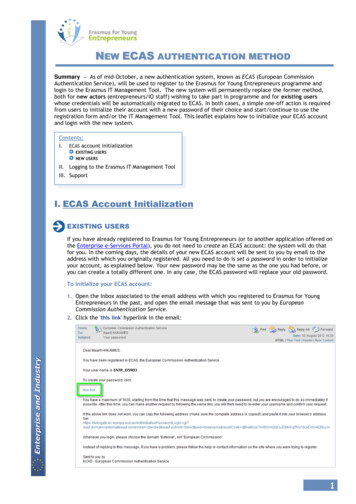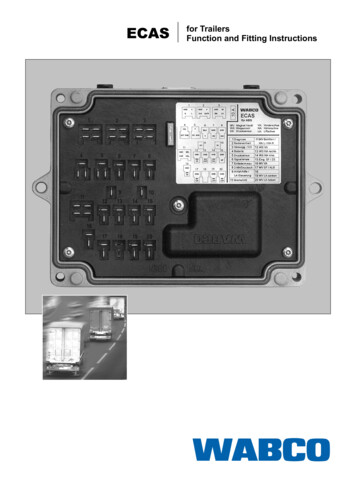
Transcription
ECASfor TrailersFunction and Fitting Instructions
Electronically Controlled Air Suspension(ECAS) for TrailersFunction and Fitting Instructions3rd EditionThis publication is not subject to any update service.New versions are available in INFORM atwww.wabco-auto.com815 010 025 38150100253 2005 WABCO The right of amendment is reservedVersion 003/10.04en815 010 025 3
Table of contentsTable of contents8.21. Important Remarks and Comments1.1Advises for Security and Risks1.2Range of Application1.3Explanation of Symbols33332. Introduction2.1System Benefits458.2.366778889998.2.48.38.3.18.3.28.3.33. System Functions3.1Reference Level Control3.1.1 Driving Level I3.1.2 Driving Levels II and III3.1.3 Unloading Level3.1.4 Memory Level3.1.5 Automatic Lowering3.2Height Limitation3.3Lateral Stabilisation3.4Lifting Axle Control3.5Offset Point Adjustment(Lifting Axle Offset)3.6Traction Help3.7Overload Protection3.8Tyre Deflection Compensation3.9Stand-By Function3.10Further ECAS-Functions on Bus andMotor Vehicle3.10.1 Control of Load Sensing Valve3.10.2 Kneeling3.10.3 Maximum in Traction Control at all time4. Basic Operation4.1Mode of Function of the ECAS BasisSystem99910101010101011115. Control Algorithm5.1Control Algorithm for Levelling Control5.2Control Algorithm for Lifting Axle Control(general)5.2.1 Control Algorithm for Lifting Axle Control(one Lifting Axle)5.2.2 Control Traction Help5.2.2.1 Trailing Axle Control (Manoeuver Aid)5.2.3 Control Algorithm for Lifting Axle Control(two separate Lifting Axles)1212146. Tyre Deflection Compensation217. System Configuration7.1Control in the Trailer7.1.1 1-Point Control7.1.2 2-Point Control7.1.3 3-Point Control22232323238. Components8.1Sensors8.1.1 Height Sensor 441 050 011 08.1.2 Pressure .68.7Electronic Control Unit (ECU)446 055 . 0InstallationPin Assignment(ECU variant 446 055 065 0)Power Supply and DiagnosticAssignmentBattery ModeECAS Solenoid ValveSpring-Returned ValvePulse-Controlled Sliding ValvesDifference between 3/2-, 2/2- and3/3-Way ValveDifferentiating of the ECAS SolenoidValves depending on their locationRemote Control Unit 446 056 116/117 0Remote Control Unit Function446 056 117 0Remote Control BoxBattery BoxPneumatic Components andInstallation Instruction2728303133343435363739394242429. Commissioning and Diagnostics9.1PC Diagnostics9.1.1 PIN9.1.2 Initializing the ECU9.2Setting Parameters9.2.1 Option Parameters9.2.2 Value Parameters9.2.3 Counts9.2.4 Explanation of Parameters9.3Calibration Process9.3.1 Height Sensor Calibration9.3.1.1 Height Sensor Calibration with the PC9.3.2 Pressure Sensor Calibration4646474748484848496565676810. Troubleshooting10.1Safety Concept10.2Troubleshooting69697111. Replacement older Components11.1Fitting a new ECU11.2Replacement of the Power SupplyModule11.3Component Replacement737312. Annex757579Trailer ECAS Parameter Setting79Explanation of theExample Parameter Records81Overview Circuit Diagrams82Parameters Records Circuit Diagrams 84Cable Overview182Certificate of German TechnicalInspection Agency184
Important Remarks and Comments1.Important Remarks and Comments1.1Advises for Security and RisksWhen the ignition is switched on or while diagnosticsstarts unexpected movements of the vehicle or suddenraise/lower of the lifting axle can occur.It is not allowed to combine ECAS with other air suspension control systems, since the possibility of dangerousinteractions cannot be excluded.Following points have to be observed when welding atthe trailer : The electronics have to disconnect from power supply(break off pin 31, 15 and 30). At least, the supply linebetween the towing vehicle and trailer is to be takenoff. System components (ECU, sensors, actuators, linesetc.) are not being contacted with welding electrodes.Never drive with the superstructure lowered onto thebuffer, because vehicle and loading can be badly damaged.You need the approval of WABCO for the: Usage of components other than those shown in thecircuit diagrams (cables, valves, sensors, remotecontrol units), Inclusion of any appliances by other manufacturers inthe system or Implementation of other functions than those described above.The structure of the ECAS system is shown by many! circuit diagrams in the annex.1.3!Explanation of SymbolsPossible dangers,Personal injury or material loss!&1.21.To work on the ECAS system, take only information shown on circuit diagrams identified with aten-digit WABCO number.Circuit diagrams without a WABCO number maybe incorrect. They are considered to be diagramsfor which no release from WABCO exists.WABCO does not assume any warranty for systems which are designed in another way than described here.ECAS is a vehicle security system. Changes on the setting of the system are allowed only to persons with necessary technical knowledge.If you work on the air suspension system, advise otherpersons by affixing an information sign on the steeringwheel of the vehicle.ECASRange of ApplicationAdditional hints, info, tipsWABCO experimental value(s),recommendationECAS was designed only for suspension control inair sprung vehicles.It is not permitted to place more than one ECAS system to a trailer. enumeration–action step refer to (prior paragraph, prior chapter,prior illustration/table)To avoid dangerous interaction, combination withother air suspension control systems are not admissible. refer to (prior paragraph, prior chapter,prior illustration/table)Important Basic Requirements for Operation withECAS: Compressed air supply must be realized sufficiently. Power supply has to be ensured. ABS connection or EBS connection must be plug in.3
2.2.ECASIntroductionIntroductionAir suspension systems have been used on motor vehicles since the 50s - especially on buses. They clearly improve ride comfort.On lorries and trailers, air suspension systems are beingincreasingly used, particularly on vehicles designed tocarry heavy loads. The main reasons for this are specialdesign criteria for the chassis. As static loads can varysignificantly on the motor vehicle's real axle, and on allaxles of a trailer from the unladen vehicle to the fully laden vehicle. Steel suspension can cause problems whenthe vehicle is unladen or partially laden. The suspensionbehaviour deteriorates. In addition, ride comfort plays animportant role, not only on buses.The Benefits of Air Suspension Systems over LeafSpring Suspension Systems Significant wear of control valves due to constant increase or decrease in pressure; shorter life due tocontinuously alternating stress control of cornering angles.Designing the control system initially with pure mechanically operating air suspension valves, soon afterwardselectromechanic control systems were developed. Thisserved to enhance operating comfort and to facilitateraising/lowering processes.ECAS is the most advanced development along theselines. The use of an ECU has achieved major improvements over the conventional system.ECAS - Electronically Controlled Air Suspension(Electronically controlled air suspension system) The whole of spring travel is available for balancingdynamic axle load cycles. Static axle load cycles arecompensated by means of pressure changes. This inturn achieving additional height for the design of thesuperstructure. The best possible suspension regardless of the roadcondition and the load carried improves ride comfortand protects the load. No rolling noise of the vehicleis transmitted. The wheels run evenly on the road surfaces; this improves braking performance and steerability and considerably extends the life of the vehicle's tyres. Accurate load-dependent control of the compressedair braking system by using the bellows pressure asthe actuating pressure for the load sensing valve. Constant vehicle height is irrespective of the staticload. Controlled raising and lowering processes for loadingramp and container operation. Control of lifting axles. Individual control of the bellows pressure to compensate lateral forces (e.g. when negotiating bends). Protecting the road surface.Disadvantages of Conventional Air Suspension Systems compared to Leaf Spring Suspension Systems More expensive system, More complicated axle systems due to the use of axlesteering and axle stabilisers, A large number of parts due to numerous air components,4ECAS is an electronically controlled air suspension system for vehicles with a large number of functions. It hasbeen used on motor vehicle since about the early 80s.In the mechanically controlled air suspension systemsthe device which measures the height also controls theair spring. While ECAS achieves control by means of anECU. It actuates the air spring via solenoid valves, usinginformation received from sensors.In addition to controlling the vehicle's level, the ECU, together with the remote control unit, also controls functions which, if implemented with conventional airsuspension systems, require a large number of components.With ECAS, additional functions can be implementedwhich cannot be achieved by conventional means.ECAS essentially operates only when the ignition is on.However, is a storage battery is used, stand-by operationcan be activated.For trailers, power is supplied from the ABS or the EBSsystem. In addition, ABS provides the so-called C3 signal, i.e. information on the vehicle's current speed. Ontrailers where ECAS works with EBS, the ECAS systemreceives information about the vehicle's speed and axleload from the EBS-ECU via a data circuit which is alsoknown as the K-line.A storage battery is provided for additional power supplyin the trailer. Due to this the trailer separated from thetowning vehicle can be adjusted in the height.
Introduction2.1System BenefitsECAS offers the following benefits:Advantages for the Trailer Manufacturer Easy installation due to pre-wired components Reduced installation time due to a smaller number ofcomponents, screw-in units, less piping Quicker system start-up via PC end-of-line.ECAS2. Very rapid raising and lowering times, High level of comfort and safety due to traction helpfor semi-trailer trains and automatic lifting axle function, Can easily be retrofitted, Low air consumption due to rugged control concept, Reduction of the amount of manoeuvring and loadingtimes and thus shorter dispatching times through storage of loading levels which are easy to adress via theremote control unit plus the option of raising or lowering only one side of the superstructure.Benefits to the Carrier Highly service-friendly, Low error liabilityAdvantages for the Owner of the Cargo Short laidup times, Protection of the load, Various safety functions for the vehicle (e.g. compensating for tyre deflection, time delay for the unloadinglevel, overload protection),Automatic return to driving level, Adaption of the vehicle to the carrying task due to theuniversal nature of the system, Reduction of the amount of manoeuvring and loadingtimes and thus shorter dispatching times through storage of loading levels which are easy to call up via theremote control unit. Highly variable operation due to different driving levels,5
3.ECAS3.System FunctionsSystem FunctionsBefore the system functions for achieving the above system advantage are explained, please note the followingbasic definitions to facilitate comprehension.Trailers can have different Types of AxlesThe Main Axle (also known as the Leading Axle)The axle is always on the the ground and cannot besteered. Every trailer has a leading axle. On drawbartrailers the rear axle is the leading axle.Steering AxleThe steering axle is an axle on a trailer which is steerable. On drawbar trailers, the front axle is the steering axle. Semi-trailers can have a the trailing axles as asteering axle.Lifting AxleThe lifting axle is usually combined with the leading axleto form an axle assembly. When the vehicle exceeds adefined axle load on its leading axle, the lifting axle islowered and can be raised again when the axle load fallsbelow a defined level.Air Suspension bellows in Air Suspension SystemsSupporting BellowsSupporting bellows are the commonly known air suspension bellows on the axles. They provide the vehicle's suspension. The supporting bellows on the axles which arein contact with the ground are always filled with a bellowspressure which is proportional to the applicable wheelload while the vehicle is in operation. The supporting bellows of raised axles are depressurised. Supporting bellows are found on all the types of axles described above.Lifting BellowsLifting bellows are firmly connected to a lever system ofthe lifting axle. They raise or lower the lifting axle whenthe pressure exceeds or falls below a defined limit pressure in the supporting bellows of the axle assembly'sdriven axle.ECAS is a control system consisting of at least one control loop. A reference value is specified in a control loop.A sensor is adapted to the system due to a calibrationprocess when the system is taken into operation. Thissensor measures the actual value of the system andsends it to an electronic control unit (ECU).The ECU compares the actual value to the reference value. During this process it is possible to determine controldeviations .6That means, that the actual value lies outside a definedreference range.In the event of a deviation the ECU initiates the correction of the reference value via an actuator.Reference Values are: Certain distances (levels) of the vehicle's superstructure above the vehicles's axle, Axle load vehicle conditions (e.g. traction help, limitpressure for lifting axle control).Two Ways to Submission the Reference Value to theECU: Fixing preference values by the vehicle manufacturerduring the systems startup by setting parameters andby calibration. The user setting the values via the remote controlunit.Please note that not all the functions described in thisdocument have to be available, depending on the type ofsystem realized. The type of system (amount of lifting axles, with/without front axle air suspension) determineswhether or not the functions can be implemented.ECAS can be fitted to every vehicle type without problems. Due to the modular construction various systemusages according to customer requirements are possible.3.1Controlling the Reference LevelThe reference level is the value for the distance betweenthe vehicle's superstructure and the axle. It is defined bycalibration, by setting parameters or by definding a valueusing a remote control unit. Correcting a reference levelis the basic functions of ECAS.The actuator is a solenoid valve by increasing and decreasing of the pressure in the supporting bellows bringing the actual level into line with the reference level. Thisoccurs if there are: Deviations over a certain tolerance range, Alteration of the reference value.Unlike conventional air suspension systems, ECAS controls not only the driving level but also any other predefined level. Therefore a level which is set for loading orunloading processes is assumed to be the referencelevel.
System FunctionsDifferentiation of Static/Dynamic Changes in theWheel LoadBy using the speed signal ECAS differentiates betweenstatic and dynamic changes in the wheel load, unlikeconventional air suspension systems. Due to this differentiation the system can react optimally to changes in thewheel load.Static Wheel Load ChangesThe static wheel load changes occur if the vehicle's loading state changes when it is stationary or moving slowly.This requires the reference value in the corresponding airsuspension bellows to be checked at short intervals andadjusted if necessary by increasing or reducing the airpressure. ECAS does this performing checks every second. This inspection cycle can be set in the parameters.Dynamic Wheel Load ChangesThe dynamic wheel load changes are mainly caused byuneven road surfaces and is more likely to occur by highspeed. Dynamic wheel load changes are usually balanced by the compliance behaviour of the supportingbellows. In this case, bellow pressurizing or ventingwould not be desirable because only the shut-off bellowhas an almost constant compliance character. For thisreason, the regulation is checked in larger intervals whenthe vehicle is moving at higher speed - usually every 60seconds. The comparison of actual value to the reference value is made continuously.It is possible to avoid unwanted corrections of dynamicwheel load changes during braking, so no air is pumpedinto or vented from the bellows, when the ECU receivesthe brake light signal.ECAS3.The vehicle's theoretical centre of gravity is a referencevalue for calculation the vehicle's braking.– Inform the system over the driving level I only by calibration process.– Control the driving level I over the vehicle's speedand/or over the remote control unit during the journey.– Set speed value for the point of actuation for controlling the parameters.3.1.2Driving Levels II and IIIBoth driving levels differ to driving level I. This may benecessary: For semi-trailers with varying truck heights to keep thetrailer in horizontal level while driving, For trailers to lowering the superstructure in order toreduce fuel consumption, For improving lateral stability at higher speed.By lowering the superstructure depending on the vehicle's speed, is based on the assumption that higherspeeds are achieved on sound road surfaces which donot require the whole of the bellows' spring stroke to beutilised.– Store the values of driving level I and II in the systemby setting the parameters and as defined variancefrom driving level I.Driving LevelThe driving level (also known as normal level) adjusts itself when the vehicle moves on a higher speed. A maximum of 3 driving levels can be set for ECAS.3.1.1.Driving Level IDriving level I referes to the reference level defined bythe vehicle manufacturer for driving under optimal conditions. This driving level is the basis for the dimensions ofthe vehicle's overall height and the vehicle's theoreticalcentre of gravity. It has a special meaning compared toother driving levels.Driving level I is described as the basic design parameterfor the vehicle.This driving level can optionally be set by: Switch, Remote control unit, Driving speed (only driving level II).The chosen driving level remains until another drivinglevel is selected.– To start up with the actual driving level touch shortlythe button driving level.– Set the values for the type and the switching points foractuation during the parameterization,Please note to take the legally permitted maximum! into account considered to the total height.– Define driving level III as the highest driving level.7
3.3.1.3ECASSystem FunctionsUnloading LevelThe unloading level is used for loading or unloading a vehicle, while it is stationary or moving at a slow speed. Itpermits the vehicle's superstructure to be brought to alevel suitable for the loading or unloading process. Theunloading level can be stipulated separately for a drawbar trailer's front and rear axles. This can be useful, forinstance, for completely emptying of a tank trailer.– The values of these unloading level are defined as thevariance from driving level I and store in the systemas part of the procedure for setting the parameters.!If an unloading level function is desired, no drivinglevel III can be set.– The unloading level is addressed via an on the ECUconnected switching contact, the so-called unloadinglevel switch.This switching contact can either be actuated manuallyor via an automatic connection to the unloading fixture(e.g. a tank valve) to readdress the current driving level.If the unloading level is active, the vehicle will return to itsdriving level as soon as a limit speed is exceeded. Whenthe speed drops below that speed, the unloading level isset once again.– The unloading level can be activated from any presetlevel.3.1.4Memory LevelTwo different memory levels can be used per system.The memory level applies to the whole of thevehicle. The use of the memory function requires a remote control unit.The Memory Level can be adressed: For loading or unloading a vehicle while it is stationaryor moving at a slow speed.This level is used in order to set a level for the superstructure which is useful for loading or unloading the vehicle.Unlike the unloading level, which is firmly stored in theECU, the memory level can be defined and changed anytime. Once defined, the system will store any memorylevel until it is changed by the user, i.e. even when the ignition has been switched off.3.1.5Automatic LoweringIf required, raised lifting axles can be lowered automatically by the driver.8This may be necessary: when the vehicle is been serviced, for improving stability on poor road surfaces.If the vehicle has two separate controlled lifting axles,anoption parameter can be set to determine whether: Both lifting axles is to be lowered. Only the second lifting axles is to be lowered.Options for Lowering Raised Lifting Axles:1. Lowering Command via Remote Control Unit– Push the Lower button on the remote control unit ofthe preselected lifting axle.The lifting axles lowers and will stay down until the system is reset by switching the ignition off and then onagain.– Push the Raise button on the remote control unit onthe preselected lifting axle.The lifting axles will raise again.2. Lowering Command via Traction Help Key– Hold button Traction Help down for longer then 5 seconds.The lifting axles will be lowered and stay down until reset.The automatic lowering function remains activated, untilthe ignition is turned off or the button is pushed againlonger then 5 seconds.All lifting axles are always lowered independent of parameter 4 Bit 4.3. By using a Separate Switch and a Line to theSwitching Input Port for Automatic Lowering onthe ECU.– Make sure the ground is connected to the contact.The lifting axles are lowered. Automatic lowering remainsactive even after the ignition is switched off or on. Thefunction remains active as long as the switch is active.– Open the contact.The lifting axles will raise again.These lowering processes are all permissible up to a limiting speed defined by parameter. If fully automatic liftingaxle operating is in place, raising will, depending on theparameter setting, occur while the vehicle is stationary orwhen it exceeds a defined speed.A vehicle with two separate lifting axles whose parameters have been set for lowering both axles and for raisingthem only when the vehicle begins to move, has its liftingaxles raised as follows:
System Functions– Deactivate automatic lowering switch.Axle 1 will be raised immediately.Axle 2 will be raised once the vehicle has been stoppedand its speed subsequently rises above that required forraising the lifting axles.3.2Lateral StabilizationVehicles expected to carry loads which are unevenly distributed across its axles (e.g. loading on one side of thevehicle only), can have variable spring rates provided onthe supporting bellows of one axle by separating the actuation for the individual bellows.– These vehicles should be fitted with 2-point control( 7. system configuration).This is not required for vehicles carrying evenly distributed loads (e.g. road tanks).3.43.Pressure Switches/-Buttons systemThe lifting axle is lowered automatically. The raising isachieved manually by means of the ECAS remote controlunit or a separate button/switch.A raised lifting axle can be lowered by way of an automatic lowering function.Height LimitationThe ECU automatically aborts any change in the level ifthe defined value for the upper and lower height limitshave been reached. These values can be freely selected.This is in order to prevent excessive strain on the rubberbuffers and height limit stops (e.g. bellows, limiting cables).3.3ECASLifting Axle ControlWhen the vehicle is stationary, its lifting axle will automatically be lowered or weight shifted to the trailing axle,when the permissible axle load of the leading axle is exceeded. The corresponding signal reaches the ECU fromthe pressure sensor ( 8.1.2 Pressure sensor) or thepressure switch at the suspension bellows of the leadingaxle. The lifting axle cannot automatically be loweredwhen the vehicle is in motion, even when pressurespikes occur.The speed up to which the lifting axle can be lowered canbe set by parameters.For safety reasons, the lifting axle is lowered when thevehicle is parked and the ignition is switched off. Optionally, the lifting axle may stay up.Pressure Sensor SystemIn systems with pressure sensors, the lifting axle can belowered and also raised automatically after the vehiclehas been unloaded. The term used for this is 'fully automatic lifting axle'.3.5Offset Point Adjustment(Lifting Axle Offset)When the lifting axle is raised, the driving level can be increased automatically. Due to this a better clearence ofthe lifting axle's wheels is achieved. This applies to thewhole of the vehicle.3.6Traction HelpOn semi-trailers, traction help can be implemented if thefully automatic lifting axle facility has been selected andthe load is heavy enough. By releasing the pressure onthe lifting axle's supporting bellows or raising the liftingaxle, the load on the towing vehicle's semi-trailer coupling and on the leading axle in increased. This meansthat the load on the driving axle of the towing vehicle isincreased, the purpose being to improve its tractionforce.– Activate the traction help function by using the remotecontrol unit or by a rocking Switch.At present, the applicable national legal provisions metby setting the corresponding parameters accordingly(with/without time speed, load limits, with/without forcedinterval). Upon EC Guideline 97/27/EC comes cominginto force, this results in changes which have been takenin account when setting the parameters.3.7Overload ProtectionBy stipulating a maximum permissible pressure for thesupporting ballows, overload protection can be activated.This protection leads to a lowering of the vehicle's superstructure down to the rubber buffers, if the supportingbellow pressure was exceeded by overloading.– You need to unload the vehicle until the vehicle's superstructure can be lifted by the remote control unit.Do not drive with the lowered superstructure, vehicle and loading can be badly damaged.9
3.3.8ECASSystem FunctionsTyre Deflection CompensatingFor vehicles with a particularly great overall height, notonly small wheels are used to maintain the vehicleheight, but a very short ride clearance is selected for theempty vehicle.However, as the vehicle is being loaded, the requiredride clearance increases. It is possible to add the tyre deflection caused by increasing the load to the possible rideclearance, at the same time keeping the overall height ofthe vehicle constant.The vehicle height required by law has to be main-! tained.3.9Stand-By FunctionIn the event of a rapid loss in pressure in the bellows (e.g.bellows leaking badly or severely damaged), the loadsensing valve would assume an empty vehicle in spite ofit being fully loaded. As a consequence, underbrakingwould ensue, and with it excessive stopping distances.ECAS contains a facility for recognizing this so that whenit occurs, the supply pressure of the air suspension system would be passed to load sensing control port 41/42.This results in a pass through of the load sensing valve.ECAS also provides this facilities for trailers. Therefore a3/2 solenoid valve has to be installed in control line between air suspension bellows and the load sensing control port 41/42.This option is mainly being used in towing vehicles.3.10.2KneelingIf a separate trailer battery and sufficient air supply areavailable, stand-by operation can be achieved for a maximum of 63.5 hours. For this purpose, the trailer does nothave to be attached to any towing vehicle, and it will atthat time address the last level before the ignition wasswitched off as the referance level. To reduce the controlcycles to a minimum it is possible to increase the tolerance range.Kneeling is a special function for buses. With the bus stationary at the bus stop, the whole of its nearside is lowered facilitate getting on and off the bus. It "kneels" infront of the passenger, so to speak. A "kerb sensor" i.e.contact strip below the entrance, prevents it from touching down on any obstacle.3.10 Further ECAS Functions on Bus andMotor VehicleECAS offers the following possibilities on motor vehicleswith lifting axle:Additional functions, although not of importance for trailers, can be implemented with the assistance of ECAS onbuses and motor vehicles.The lifting axle is lowered in load conditions. The distribution of the axle load across the rear axle assembly canbe controlled in such a way that the driving axle (withinthe scope of legal provisions and the stipulatons by theaxle manufacturers) carries the greatest possible load,with the lifting axle supporting the residual load. Thus thedriving forces which can be transferred to the driven axleare always at their maximum, thereby permitting goodtraction.3.10.1Control of Load Sensing ValveTowing vehicles and trailers with air suspension systemsand a conventional braking system have a load sensingvalve fitted which is controlled by the bellows pressure.103.10.3Maximum in Traction Control at all time
ECASBasic Operation4.Basic OperationIn this chapter the operation of ECAS will now be lookedat in a little more detail.The basic purpose of ECAS is to balance any control deviations. Control deviations are caused either by disturbances (such as a change in the load) or by changes inthe reference values (e.g. by way of the remote controlunit). These control devariation cause the distance between the vehicle's axle and its superstructure to change.ECAS balances these control deviations by means oflevelling control.4.14.The intervals depend on the vehicles type of operating (driving or loading operation).2. This measured value is used
ECAS essentially operates only when the ignition is on. However, is a storage battery is used, stand-by operation can be activated. For trailers, power is supplied from the ABS or the EBS system. In addition, ABS provides the so-called C3 sig-nal, i.e. information on the vehicle's current speed. On trailers where ECAS works with EBS, the ECAS .
